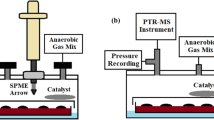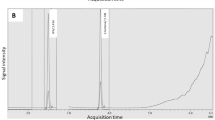Abstract
One of the tasks of food law enforcement authorities is to supervise the composition of cosmetics. In the case of mouthwashes, they are likely to contain (labeled or unlabeled) antimicrobial compounds. Conventional analyses, such as high-performance liquid chromatography (HPLC) and gas chromatography (GC) only shed light on a compound’s structure, but not on its biological function. In this study, we demonstrate that the task of detecting antimicrobials in mouthwashes can be streamlined using the luminescent bacterium Vibrio fischeri as a biodetector coupled with high-performance thin-layer chromatography (HPTLC) as a pre-separation method. The employment of subsequent conventional techniques could then be restricted to fractions with proven V. fischeri toxicity. Samples were separated in parallel on silica gel and amino layer HPTLC plates, developed with a solvent system containing tertiary butyl methyl ether and n-hexane and dried on a plate heater. After applying V. fischeri onto the HPTLC plate, zones of interest were extracted from a parallel plate and identified by HPLC–UV or GC-mass spectrometry. The reaction of V. fischeri to more than 40 standard substances which might be present in mouthwashes was determined. Based on this information, six commercially available mouthwashes were analyzed. The workflow proved to be viable for an effect-directed screening for antimicrobial compounds. The analysis of mouthwashes revealed that not only declared preservatives are used (sodium benzoate, cetylpyridinium chloride) but also other compounds, especially constituents of essential oils. Because their main purpose is flavoring of the mouthwash, they are summarized as “aroma” (anethole, carvone, menthol, thymol) which is in compliance with legal restrictions.




Similar content being viewed by others
References
IQWiG—Institut für Qualität und Wirtschaftlichkeit im Gesundheitswesen (2011) Merkblatt: Zähne und Zahnfleisch lange gesund halten. http://www.Gesundheitsinformation.de. Accessed 21 Nov 2011
Stiftung Warentest (2003) Mundspüllösungen—Krieg den Keimen. Test 1:25–29
Barnett ML (2006) The rationale for the daily use of an antimicrobial mouthrinse. J Am Dent Assoc 137(3):16S–21S
Fey H (1985) Wörterbuch der Kosmetik. Wissenschaftliche Verlagsgesellschaft mbH Stuttgart. 2. edn
Eidgenössisches Departement des Inneren (2005) Verordnung des EDI über kosmetische Mittel (VKos) of 23 Nov 2005 (status of 1 Nov 2010)
Eberz G, Rast H-G, Burger K, Kreiss W, Weisemann C (1996) Bioactivity screening by chromatography-bioluminescence coupling. Chromatographia 43(1/2):5–9
Kreiss W, Eberz G, Rast H-G, Weisemann C (2003) Method and device for detection of biologically active substances. European Patent No. EP 1359226 A2
Morlock G, Schwack W (2010) Hyphenations in planar chromatography. J Chromatogr A 1217(43):6600–6609
Schulz W, Seitz W, Weiss SC, Weber WH, Böhm M, Flottmann D (2008) Use of Vibrio fischeri for screening for bioactivity in water analysis. J Planar Chromatogr—Mod TLC 21(6):427–430
Baumgartner V, Schwack W (2010) Enhanced quantitative evaluation of the HPTLC-bioluminescence detection. J Liq Chromatogr Related Technol 33(7):980–995
Verbitski SM, Hickey S, Gourdin GT, Ikenouye LM (2007) Bioluminex: an effective yet simple tool for screening mixtures. CAMAG Bibliography Service 99:11–13
CAMAG Laboratory (2007) Biological activity of berberine containing drugs by HPTLC-Bioluminescence screening. CAMAG Laboratory Application Notes F-34
Baumgartner V, Hohl C, Hauri U (2009) Bioactivity-Based Analysis of Sunscreens Using the Luminescent Bacteria Vibrio fischeri. J Planar Chromatogr—Mod TLC 22(1):19–23
Klöppel A, Grasse W, Brümmer F, Morlock GE (2008) HPTLC coupled with bioluminescence and mass spectrometry for bioactivity-based analysis of secondary metabolites in marine sponges. J Planar Chromatogr—Mod TLC 21(6):431–436
Baumgartner V, Hohl C, Schwack W (2011) Rolling—a new application technique for luminescent bacteria on high-performance thin-layer chromatography plates. J Chromatogr A 1218:2692–2699
Kreiss W, Eberz G, Rast H-G, Weisemann C (2002) Offenlegungsschrift DE 102 19 031 A1. Anmeldetag 29.04.2002, Offenlegungstag 20.11.2003
Niederer M, Bollhalder R, Hohl C (2006) Determination of fragrance allergens in cosmetics by size-exclusion chromatography followed by gas chromatography-mass spectrometry. J Chromatogr A 1132:109–116
CAMAG Laboratory (2011) Flow Chart TLC/HPTLC method development. http://www.camag.com/brochures. Accessed 24 Dec 2011
Reich E, Schibli A (2007) High-Performance Thin-Layer Chromatography for the Analysis of Medicinal Plants. Thieme, Stuttgart
Bassolé IHN, Juliani HR (2012) Essential oils in combination and their antimicrobial properties. Molecules 17:3989–4006
De M, De AK, Sen P, Banerjee AB (2002) Antimicrobial properties of star anise (Illicium verum Hook f). Phytother Res 16(1):94–95
Işcan G, Kïrïmer N, Kürkcüoğlu M, Başer KHC, Demïrcï F (2002) Antimicrobial screening of Mentha piperita essential oils. J Agric Food Chem 50:3943–3946
Salleh WMNHW, Ahmad F, Yen KH, Sirat HM (2011) Chemical compositions, antioxidant and antimicrobial activities of essential oils of piper caninum Blume. Int J Mol Sci 12:7720–7731
IPCS INCHEM (1996) Vanillin (CAS: 121-33-5). http://www.inchem.org/documents/sids/sids/121335.pdf. Accessed 29 Mar 2012
Fitzgerald DJ, Stratford M, Gasson MJ, Ueckert J, Bos A, Narbad A (2004) Mode of antimicrobial action of vanillin against Escherichia coli, Lactobacillus plantarum and Listeria innocua. J Appl Microbiol 97:104–113
Russell AD (1986) Chlorhexidine: antibacterial action and bacterial resistance. Infection 14(5):212–215
Paulus W (ed) (2005) Directory of microbicides for the protection of materials—a handbook. Springer, NewYork
Eisenbrand G, Schreier P (eds) (1995) Römpp Lexikon Lebensmittel-Chemie. Thieme, Stuttgart
Singh PP, Jha S, Irchhaiya R, Fatima A, Agarwal P (2012) A Review on phytochemical and pharmacological potential of Calamintha officinalis Moench. IJPSR 3:1001–1004
Dorman HJD, Deans SG (2000) Antimicrobial agents from plants: antibacterial activity of plant volatile oils. J Appl Microbiology 88(2):308–316
Acknowledgments
We thank our colleagues at the State Laboratory Basel-City, Dr. Urs Hauri and his team for the advice and the help with HPLC–DAD, and Dr. Markus Niederer and his team for the assistance with the GC–MS. Furthermore, we thank CAMAG, especially Mr. Leuenberger, for the support concerning the HPTLC equipment. We would also like to thank Mr. Handloser (CAMAG) and Mr. Schulz (Merck Millipore/Lab Solutions, R&D Thin-layer chromatography) for the information on the properties of HPTLC layers.
Author information
Authors and Affiliations
Corresponding author
Additional information
Published in the topical collection Miniaturized and New Featured Planar Chromatography and Related Techniques with guest editor Paweł K. Zarzycki.
Rights and permissions
About this article
Cite this article
Baumgartner, V., Hohl, C. & Schwack, W. Screening for Antimicrobials in Mouthwashes Using HPTLC-Bioluminescence Detection. Chromatographia 76, 1315–1325 (2013). https://doi.org/10.1007/s10337-012-2375-5
Received:
Revised:
Accepted:
Published:
Issue Date:
DOI: https://doi.org/10.1007/s10337-012-2375-5




